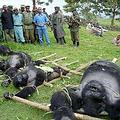 第22屆國際靈長類學會(International Primatological Society Congress)於蘇格蘭愛丁堡舉行,世界靈長類權威學家們於會中指出,猴子、猿人與其他靈長類生物正逐步從地球上消失,部分甚至是因為成為人類桌上佳餚而瀕絕。
第22屆國際靈長類學會(International Primatological Society Congress)於蘇格蘭愛丁堡舉行,世界靈長類權威學家們於會中指出,猴子、猿人與其他靈長類生物正逐步從地球上消失,部分甚至是因為成為人類桌上佳餚而瀕絕。
人類焚毀並拓墾森林的行為,不但排放占全球總排放量20%的溫室氣體,破壞棲地更是對靈長類生物最大的威脅。其他威脅源亦包括人類獵食與非法交易等。
會中所發表的第一份近5年來靈長類保育工作評鑑中統計出,依據世界自然保育聯盟編訂之瀕絕物種紅皮書標準,世界上634種靈長類中,近乎半數處於絕種邊際。
所有的大型人猿,如大猩猩、黑猩猩、紅毛猩猩與倭黑猩猩,在名單上不是被歸於瀕絕就是嚴重瀕絕之類別。以越南與柬埔寨兩國為例,境內高達90%的靈長類生物生活在絕種的風險之下。人類為了美食及滿足古傳中藥和寵物等市場交易的需求,不斷地獵殺且讓棲地變得不安全,致使長臂猿、葉猴、長尾葉猴與其他生物的數量銳減。
除此之外,報告中亦顯示,小如鼠狐猴,大至山地大猩猩之間的物種,其生存皆倍受威脅。非洲大陸上13種紅疣猴中,已有11種經評估後被列名於嚴重瀕絕或瀕絕名單。其中Procolobus pennantiibouvieri與Procolobus badius waldroni兩物種可能已經絕種,前者已有25年不曾為人類所目睹;而靈長類學家上一次發現後者的時間則早在1978年之遙。
報告指出,非人類靈長類動物在其居住的生態系統中扮演著舉足輕重的角色。從散布種子和其他與環境互動的行為,靈長類動物有助於熱帶森林中野生動植物生態的運行。健全的森林體系不但可提供當地住民重要資源,同時亦可吸收並儲存二氧化碳,緩和氣候變遷。
儘管報告對靈長類物種的生存評估不樂觀,保育人士們則分享一項令人鼓舞的復育成果。2003年在保育工作的努力下,巴西黑獅狨與金獅狨兩靈長類,已從嚴重瀕絕名單回到瀕絕名單,儘管兩者數量仍在少數,不過保育人士指出,加強造林工程提供這些生物新的棲地,才能真正有助於靈長類動物的長期復育計劃與生存。
在此同時,科學家們有鑑於山地大猩猩在盧安達、烏干達與剛果民主共和國山區叢林保護區內數量增長,亦考慮將其生存地位遵循前例,從嚴重瀕絕等級降至瀕臨絕種。然而,受2007年殺害8隻山地大猩猩事件影響,及顧慮到這些地區政治動盪等因素,暫擬延議重新歸類的計劃。
大猩猩、倭黑猩猩與黑猩猩可於非洲共計21個國家中發現其踪跡。紅毛猩猩方面,其中一物種已深入印尼蘇門達臘最北方,而另一支分成三亞種,棲身於婆羅州島上。
Monkeys, apes and other primates are vanishing from the face of the Earth, with some "literally being eaten to extinction," according to the world's foremost primate authorities gathered this week at the 22nd International Primatological Society Congress in Edinburgh.
Habitat destruction, through the burning and clearing of tropical forests, which also emits at least 20 percent of global greenhouse gases, is a major threat to primates. Other threats include the hunting of primates for food and the illegal wildlife trade.
The first comprehensive review in five years of primate conservation status presented at the conference shows that of the 634 kinds of primates in the world, almost half are in danger of going extinct, according to the criteria of the Red List of Threatened Species compiled by the IUCN.
All great apes - all gorillas, all chimpanzees, all orangutans, all bonobos - are either Endangered or Critically Endangered. In both Vietnam and Cambodia, 90 percent of primate species are considered at risk of extinction. Populations of gibbons, leaf monkeys, langurs and other species have dwindled due to habitat loss worsened by hunting for food and to supply the wildlife trade in traditional Chinese medicine and pets.
Elsewhere, the survival of species from tiny mouse lemurs to massive mountain gorillas is in jeopardy, the report shows. In Africa, 11 of the 13 kinds of red colobus monkeys assessed were listed as Critically Endangered or Endangered. Two may already be extinct: Bouvier's red colobus, Procolobus pennantiibouvieri, has not been seen in 25 years, and no living Miss Waldron's red colobus, Procolobus badius waldroni, has been seen by a primatologist since 1978.
Non-human primates are important to the health of their surrounding ecosystems, the report points out.
Through the dispersal of seeds and other interactions with their environments, primates help support plant and animal life in tropical forests. Healthy forests provide vital resources for local human populations, and also absorb and store carbon dioxide that causes climate change.
Despite the grim assessment, conservationists point to one success in helping targeted species recover. In 2003, two Brazilian primates - the black lion tamarin and the golden lion tamarin which were downlisted to Endangered from Critically Endangered are now well-protected but remain small, and conservationists say there is an urgent need for reforestation to provide new habitat for their long-term survival.
Scientists also considered reclassifying the mountain gorilla to Endangered from Critically Endangered due to increasing populations in their only habitat - the protected mountain jungles of Rwanda, Uganda and Democratic Republic of Congo. But the slayings of eight mountain gorillas in 2007 and continuing political turmoil in the region delayed the planned reclassification.
In total, the gorillas, bonobo and chimpanzees occur in 21 African nations. Of the orangutans, one species is wedged into northernmost Sumatra, and the other, divided into three subspecies, survives on the island of Borneo.
全文及圖片詳見:ENS





